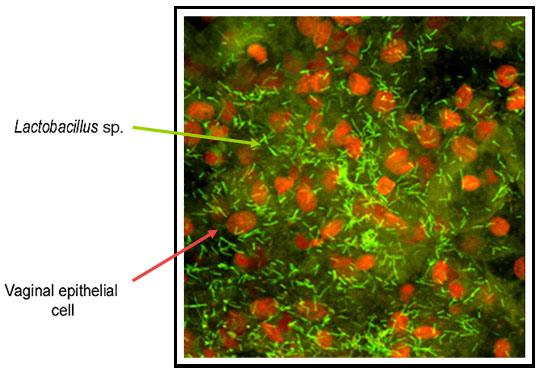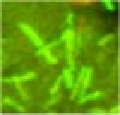Lactobacillus jensenii: Difference between revisions
| Line 50: | Line 50: | ||
Some of the recent researches on Lactobacillus jensenii: | Some of the recent researches on Lactobacillus jensenii: | ||
1. | 1. Live Microbial Microbicides for HIV | ||
Lactobacillus jensenii has been genetically modified to produce and secrete peptide that prevents fusion with HIV using S-protein layer secretion pathway. Genetically engineered L. jensenii was able to proliferate in the vaginas of estrus phase mice and maques as well as secrete this anti-HIV peptide. This may be an inexpensive and convenient way to block HIV infection and/or replication. | Lactobacillus jensenii has been genetically modified to produce and secrete peptide that prevents fusion with HIV using S-protein layer secretion pathway. Genetically engineered L. jensenii was able to proliferate in the vaginas of estrus phase mice and maques as well as secrete this anti-HIV peptide. This may be an inexpensive and convenient way to block HIV infection and/or replication. | ||
Revision as of 02:18, 29 April 2007

Classification
Higher order taxa
Bacteria; Firmicutes; Bacilli; Lactobacillales; Lactobacillaceae; Lactobacillus
Genus
Lactobacillus jensenii
|
NCBI: Taxonomy |
Description and significance
From the genus Lactobacillus, L. jensenii is a "facultatively anaerobic, catalase-negative, none-spore-forming, Gram Positive, rod-shaped" bacteria. This particular strain is one of the predominant species(along with Lactobacillus crispatus) found in the female lower genital tract. Because this bacteria is a natural vaginal strain, this novel microorganism has become a special interest to HIV/AIDS researchers who are looking for a shuttle of HIV inhibitor cyanovirin-N (CV-N) that they can genetically modify. So, to facilitate efficient expression of CV-N by this bacterium, L. jensenii 1153 genome has been sequenced by shotgun approach.

So far, its pathogenicity for men is unknown.
Genome structure
Describe the size and content of the genome. How many chromosomes? Circular or linear? Other interesting features? What is known about its sequence? Does it have any plasmids? Are they important to the organism's lifestyle?
L. jensenii 1153 genome has been sequenced.
Cell structure and metabolism
Describe any interesting features and/or cell structures; how it gains energy; what important molecules it produces.
L. jensenii could be differentiated from other species of lactobacilli by the following combination of characteristics: production of only D-lactate, hydrolysis of arginine, and fermentation of cellobiose, galactose, and ribose, but not of lactose.
Ecology
Describe any interactions with other organisms (included eukaryotes), contributions to the environment, effect on environment, etc.
Pathology
How does this organism cause disease? Human, animal, plant hosts? Virulence factors, as well as patient symptoms.
Application to Biotechnology
Does this organism produce any useful compounds or enzymes? What are they and how are they used?
Current Research
Some of the recent researches on Lactobacillus jensenii:
1. Live Microbial Microbicides for HIV
Lactobacillus jensenii has been genetically modified to produce and secrete peptide that prevents fusion with HIV using S-protein layer secretion pathway. Genetically engineered L. jensenii was able to proliferate in the vaginas of estrus phase mice and maques as well as secrete this anti-HIV peptide. This may be an inexpensive and convenient way to block HIV infection and/or replication.
2.
References
Edited by Frances Cho, student of Rachel Larsen at UCSD.
